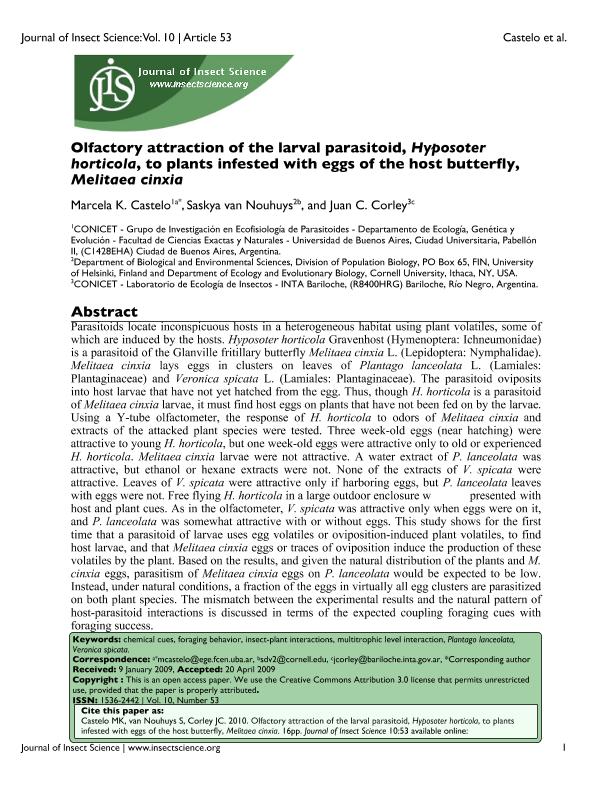Mostrar el registro sencillo del ítem
dc.contributor.author
Castelo, Marcela Karina

dc.contributor.author
Nouhuys, Saskya van
dc.contributor.author
Corley, Juan Carlos

dc.date.available
2019-01-25T22:03:46Z
dc.date.issued
2010-06
dc.identifier.citation
Castelo, Marcela Karina; Nouhuys, Saskya van; Corley, Juan Carlos; Olfactory Attraction of the Larval Parasitoid, Hyposoter horticola , to Plants Infested with Eggs of the Host Butterfly, Melitaea cinxia; University of Arizona; Journal of Insect Science; 10; 53; 6-2010; 1-16
dc.identifier.issn
1536-2442
dc.identifier.uri
http://hdl.handle.net/11336/68701
dc.description.abstract
Parasitoids locate inconspicuous hosts in a heterogeneous habitat using plant volatiles, some of which are induced by the hosts. Hyposoter horticola Gravenhost (Hymenoptera: Ichneumonidae) is a parasitoid of the Glanville fritillary butterfly Melitaea cinxia L. (Lepidoptera: Nymphalidae). Melitaea cinxia lays eggs in clusters on leaves of Plantago lanceolata L. (Lamiales: Plantaginaceae) and Veronica spicata L. (Lamiales: Plantaginaceae). The parasitoid oviposits into host larvae that have not yet hatched from the egg. Thus, though H. horticola is a parasitoid of Melitaea cinxia larvae, it must find host eggs on plants that have not been fed on by the larvae. Using a Y-tube olfactometer, the response of H. horticola to odors of Melitaea cinxia and extracts of the attacked plant species were tested. Three week-old eggs (near hatching) were attractive to young H. horticola, but one week-old eggs were attractive only to old or experienced H. horticola. Melitaea cinxia larvae were not attractive. A water extract of P. lanceolata was attractive, but ethanol or hexane extracts were not. None of the extracts of V. spicata were attractive. Leaves of V. spicata were attractive only if harboring eggs, but P. lanceolata leaves with eggs were not. Free flying H. horticola in a large outdoor enclosure were presented with host and plant cues. As in the olfactometer, V. spicata was attractive only when eggs were on it, and P. lanceolata was somewhat attractive with or without eggs. This study shows for the first time that a parasitoid of larvae uses egg volatiles or oviposition-induced plant volatiles, to find host larvae, and that Melitaea cinxia eggs or traces of oviposition induce the production of these volatiles by the plant. Based on the results, and given the natural distribution of the plants and M. cinxia eggs, parasitism of Melitaea cinxia eggs on P. lanceolata would be expected to be low. Instead, under natural conditions, a fraction of the eggs in virtually all egg clusters are parasitized on both plant species. The mismatch between the experimental results and the natural pattern of host-parasitoid interactions is discussed in terms of the expected coupling foraging cues with foraging success.
dc.format
application/pdf
dc.language.iso
eng
dc.publisher
University of Arizona

dc.rights
info:eu-repo/semantics/openAccess
dc.rights.uri
https://creativecommons.org/licenses/by/2.5/ar/
dc.subject
Chemical Cues
dc.subject
Foraging Behavior
dc.subject
Hyposoter Horticola
dc.subject
Melitaea Cinxia
dc.subject
Insect-Plant Interactions
dc.subject
Multitrophic Level Interaction
dc.subject
Plantago Lanceolata
dc.subject
Veronica Spicata
dc.subject.classification
Otras Ciencias Biológicas

dc.subject.classification
Ciencias Biológicas

dc.subject.classification
CIENCIAS NATURALES Y EXACTAS

dc.title
Olfactory Attraction of the Larval Parasitoid, Hyposoter horticola , to Plants Infested with Eggs of the Host Butterfly, Melitaea cinxia
dc.type
info:eu-repo/semantics/article
dc.type
info:ar-repo/semantics/artículo
dc.type
info:eu-repo/semantics/publishedVersion
dc.date.updated
2019-01-25T13:39:01Z
dc.journal.volume
10
dc.journal.number
53
dc.journal.pagination
1-16
dc.journal.pais
Estados Unidos

dc.journal.ciudad
Tucson
dc.description.fil
Fil: Castelo, Marcela Karina. Consejo Nacional de Investigaciones Científicas y Técnicas. Oficina de Coordinación Administrativa Ciudad Universitaria. Instituto de Ecología, Genética y Evolución de Buenos Aires. Universidad de Buenos Aires. Facultad de Ciencias Exactas y Naturales. Instituto de Ecología, Genética y Evolución de Buenos Aires; Argentina
dc.description.fil
Fil: Nouhuys, Saskya van. University of Helsinski; Finlandia. Cornell University; Estados Unidos
dc.description.fil
Fil: Corley, Juan Carlos. Consejo Nacional de Investigaciones Científicas y Técnicas; Argentina. Instituto Nacional de Tecnología Agropecuaria. Centro Regional Patagonia Norte. Estación Experimental Agropecuaria San Carlos de Bariloche. Laboratorio de Ecología de Insectos; Argentina
dc.journal.title
Journal of Insect Science

dc.relation.alternativeid
info:eu-repo/semantics/altIdentifier/doi/http://dx.doi.org/10.1673/031.010.5301
dc.relation.alternativeid
info:eu-repo/semantics/altIdentifier/url/https://academic.oup.com/jinsectscience/article/10/1/53/837856
dc.relation.alternativeid
info:eu-repo/semantics/altIdentifier/url/https://www.ncbi.nlm.nih.gov/pmc/articles/PMC3014809/
Archivos asociados
